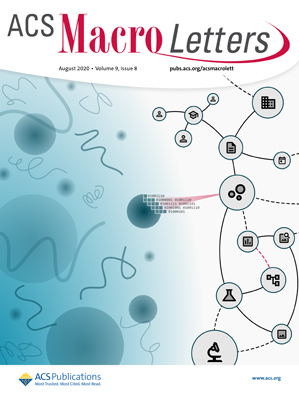酶解聚速率与类聚乙烯长链脂肪族聚酯结构的相关性。
IF 5.2
Q1 POLYMER SCIENCE
引用次数: 0
摘要
长链脂肪族聚酯是新兴的可持续材料,具有类似聚乙烯的特性,同时适合化学回收和生物降解。然而,不同的聚酯化学结构会导致明显不同的降解率,而这些降解率并不能从聚合物熔融温度等通常相关的大体积聚酯特性中预测出来。为了阐明这些结构与降解性之间的关系,我们对不同单体成分和结晶度的长链聚酯进行了酶水解,并通过检测形成的单体对水解速率进行了量化。与链长较短的二元醇单体共聚物相比,水溶性较差的长链二元醇单体(如 1,18-十八烷二醇)共聚物的解聚速率大大降低。例如,由 1,4-丁二醇和 1,18-十八烷二羧酸单体组成的 PE-4,18 的水解速度比 PE-18,4 快 20 倍。水解时释放出的不溶性长链二元醇单体被认为仍附着在聚合物表面,从而降低了酶对剩余酯键进一步水解的可及性。通过引入支化单体来调节聚酯结晶度可导致不同的水解速率,当结晶度从 72% 降至 45% 时,水解速率会增加一个数量级。报告的结果有助于设计出具有均衡材料特性和解聚适应性的聚酯结构。本文章由计算机程序翻译,如有差异,请以英文原文为准。
Correlation of Enzymatic Depolymerization Rates with the Structure of Polyethylene-Like Long-Chain Aliphatic Polyesters.
Long-chain aliphatic polyesters are emerging sustainable materials that exhibit polyethylene-like properties while being amenable to chemical recycling and biodegradation. However, varying polyester chemical structures results in markedly different degradation rates, which cannot be predicted from commonly correlated bulk polyester properties, such as polymer melting temperature. To elucidate these structure-degradability relationships, long-chain polyesters varying in their monomer composition and crystallinity were subjected to enzymatic hydrolysis, the rates of which were quantified via detection of formed monomers. Copolymers with poorly water-soluble, long-chain diol monomers (e.g., 1,18-octadecanediol) demonstrated strongly reduced depolymerization rates compared to copolymers with shorter chain length diol monomers. This was illustrated by, e.g., the 20× faster hydrolysis of PE-4,18, consisting of 1,4-butanediol and 1,18-octadecanedicarboxylic acid monomers, relative to PE-18,4. The insoluble long-chain diol monomer released upon hydrolysis was proposed to remain attached to the bulk polymer surface, decreasing the accessibility of the remaining ester bonds to enzymes for further hydrolysis. Tuning of polyester crystallinity via the introduction of branched monomers led to variable hydrolysis rates, which increased by an order of magnitude when crystallinity decreased from 72% to 45%. The results reported enables the informed design of polyester structures with balanced material properties and amenability to depolymerization.
求助全文
通过发布文献求助,成功后即可免费获取论文全文。
去求助
来源期刊
CiteScore
10.40
自引率
3.40%
发文量
209
审稿时长
1 months
期刊介绍:
ACS Macro Letters publishes research in all areas of contemporary soft matter science in which macromolecules play a key role, including nanotechnology, self-assembly, supramolecular chemistry, biomaterials, energy generation and storage, and renewable/sustainable materials. Submissions to ACS Macro Letters should justify clearly the rapid disclosure of the key elements of the study. The scope of the journal includes high-impact research of broad interest in all areas of polymer science and engineering, including cross-disciplinary research that interfaces with polymer science.
With the launch of ACS Macro Letters, all Communications that were formerly published in Macromolecules and Biomacromolecules will be published as Letters in ACS Macro Letters.

 求助内容:
求助内容: 应助结果提醒方式:
应助结果提醒方式:


